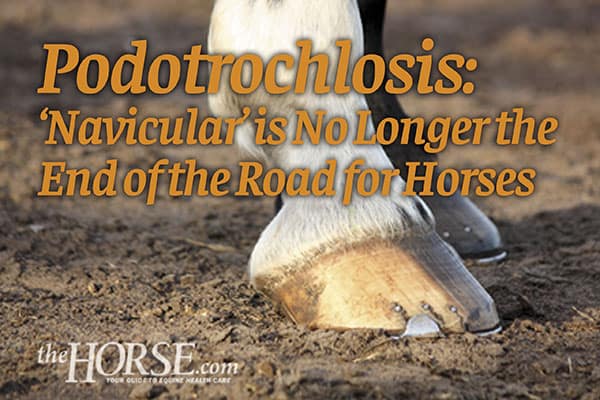Horse Heel Pain: Diagnosis and Treatment

Different but often related: Here’s how to address common heel conditions in horses
Think about the size of a horse. Now think about the size of his hoof. When you compare one to the other, it’s dazzling to consider how much something so small can carry. Then factor in the speed and height at which equine athletes perform—there’s no doubt your horse’s feet withstand enormous amounts of weight, strain, pressure, and impact. With each footfall the heels are the first part of the equine digit to hit the ground. Their sponginess and flexibility allow them to expand and absorb some concussion, dissipating shock before it travels upward. This mechanism helps protect bones and joints in the hoof capsule from the damaging effects of repetitive high-impact forces. With such an important role to fill, it’s easy to see why distorted, injured, or painful heels can hurt the horse’s overall performance and soundness.
One Region, Multiple Conditions
Too often, disparate causes of equine heel pain are clumped together under the dreaded term “navicular.”
“But prognosis and treatment for various caudal (toward the rear) hoof conditions are drastically different, so it is imperative to parse out the actual cause of the pain,” says Jaret Pullen, DVM, owner of JP Hoofworks, an equine podiatry veterinary service that serves the greater New England area. Much like you would treat a cut or blister on your heel differently than an injury to your calcaneus (heel bone), distinguishing between lameness stemming from the heels of the horse versus the deeper, more complex podotrochlear apparatus is crucial.
Step 1: Localizing Lameness
Before all else, your veterinarian must determine where the lameness is coming from. While seeking answers, practitioners conduct physical and lameness examinations, which generally involve hoof testers and wedge tests. Then they use regional analgesia (nerve blocks) and radiographs as needed.
Accurately and precisely locating the problem area is key, as our sources emphasize throughout this article. “On the one hand, general heel pain refers to the actual heel structures: heel bulbs, bars, digital cushion, and the palmar processes of P3 (the branches of the coffin bone that extend backward and to which the lateral cartilages attach),” says Pullen. “As for the navicular or podotrochlear apparatus, it includes much more than the navicular bone, as some may think. Along with the navicular bone and bursa, the podotrochlear region of the foot also contains suspensory ligaments, impar ligaments, and the distal end of the deep digital flexor tendon (DDFT).” These parts work together to create a pulleylike system; injury to or degeneration of any of them qualifies as podotrochlosis.
Getting a Podotrochlosis Diagnosis

Fast forward to 2022, and veterinarians have made tons of progress when it comes to diagnosing podotrochlosis. Historically, the equine foot has presented unique diagnostic imaging challenges. That’s because radiographs provide very limited information about soft tissue structures, and ultrasound waves—which do allow a detailed look at tendons, ligaments, and synovial structures—cannot penetrate the rigid hoof capsule. The recent rise in accessibility of MRI has been a game-changer for veterinarians. This high-tech modality enables practitioners to precisely identify musculoskeletal structures—including soft tissues—associated with pain and lameness in the equine foot.
“In fact, I typically will not make the call on podotrochlear syndrome without the aid of an MRI or nuclear scintigraphic (bone scan) study,” says Mark Silverman, DVM, MS, owner of Sporthorse Veterinary Services and Southern California Equine Podiatry Center, in Rancho Santa Fe. “I am hesitant to apply a label that will follow the horse through his career without solid data backing me up. Podotrochlosis is a complex disease that, in my opinion, is often overdiagnosed.”
Dr. Jaret Pullen
We Have a Diagnosis: What’s Next?
Let’s say your horse does have a veterinarian-confirmed podotrochlosis diagnosis. What now? With a plethora of treatment options available, practitioners must communicate clearly with their clients, setting realistic expectations. “My typical protocol for addressing a horse newly diagnosed with navicular changes starts by having an honest conversation with the owner and trainer,” says Pullen. “It is important that everyone is on the same page. There are many routes we can take, all of which differ in price, effectiveness, and speed. Before proceeding, I want to understand the owner’s goals and finances, as well as how the horse is currently going.”
A few decades ago navicular syndrome was often a death sentence for a horse’s athletic career—even for the animal himself in advanced cases. But improvements in both diagnostic and treatment options have given hope to many horse owners. “This being said, it’s important to understand that podotrochlosis remains a degenerative condition,” Pullen says. “And while we can often improve and extend the horse’s soundness, we cannot reverse the pathology. Things will likely continue to get worse, following a timeline we often cannot predict.”
How To Help the Horse With Podotrochlosis
The focus of podotrochlosis management is to keep the horse comfortable, sound, and—when possible—in work. Among the many therapeutic options, corrective shoeing is almost always the veterinarian’s first recourse. “Often, when I find myself confronted with a case of caudal hoof lameness, I am almost glad to see shoeing that is contrary to what the individual horse appears to need,” says Silverman. That’s because therapeutic shoeing carries enormous potential to improve the soundness of a horse with podotrochlosis.
“I heavily rely on therapeutic shoeing and non-steroidal anti-inflammatory drugs (NSAIDs) as a first-line treatment,” adds Pullen. “Altering the biomechanics (through corrective shoeing) is one of the few options that actually changes some of the root causes of the inflammation. The overarching principle of most therapeutic shoeing is to shift pressure away from the compromised area to the healthier regions of the foot. In this case the objective is to shift the load away from the podotrochlear region, and we achieve this by reducing the tension of the DDFT over the navicular area.”
Beyond those initial steps, Pullen’s approach depends on the timeline and constraints with which he has to work: “For instance, if the patient is a performance horse, and return to work is imperative, I employ an aggressive, multifaceted approach incorporating joint and/or navicular bursa injections for immediate inflammation reduction. I also turn to bisphosphonates (Osphos or Tildren). These drugs will take a few weeks to reach full effect on bone metabolism, during which the shoeing changes, NSAIDs, and joint/bursa injections have had time to work,” he explains. “The bisphosphonates, which reduce painful bone remodeling, prolong the effectiveness of the shoeing changes and injections.”
Navicular bursoscopy (a surgical procedure in which the practitioner uses arthroscopy to debride the lesions and adhesions) might be indicated for some horses with DDFT tears.
Revisiting the Treatment Protocol: Second Opinions
When called in to provide a second opinion, rather than laying out a fresh game plan for a horse newly diagnosed with podotrochlosis, Silverman has a list of important questions to ask the referring veterinarian:
- What is the current medical approach?
- What is the horse’s current shoeing?
- Has the horse received intra-articular medication in the coffin joint and/or navicular bursa?
- Is the horse on any rheological agents to improve blood flow to the affected region or bisphosphonates to regulate bone density?
- Have other therapeutic modalities been used? What has been the horse’s response to those approaches?
“Unless the diagnostic findings are horrible, some combination of therapeutic changes should result in some degree of improvement for podotrochlosis cases,” says Silverman.
Take-Home Message for Veterinarians and Farriers
For the practitioner tasked with evaluating and modifying the shoeing of a horse with podotrochlosis, Pullen shares his methodology: “Using podiatry-style radiographs, I will measure the digital breakover length, the palmar angle (PA), and the tendon surface angle of the navicular bone. Measuring the PA and the tendon surface angle changes between pre- and post-shoeing enables me to assess mechanical changes and the clinical response objectively. In these cases I have two main objectives:
- “Raise the heel to shorten the linkage from the origin to the insertion of the DDFT.
- “Ease breakover. Using a wedged full roller motion or rocker shoe, I bring the breakover of the shoe back so that it is directly under the center of rotation for the distal interphalangeal joint. This serves to remove some of the leverage force and, thus, reduce pressure across the navicular region. Additionally, using a rockered-wedge shoe will raise the PA to lessen the interaction forces of the DDFT against the navicular region.”
When the Heels Are Too Low
Underrun heels are a conformational fault that occurs when the heels grow forward rather than downward, becoming too low. Underrun heels, especially when combined with a long toe, accentuate the forces placed on the caudal foot, thus making the navicular bone and associated structures prone to podotrochlosis. This is especially true if the foot’s structure creates a negative palmar angle (NPA), meaning the back half of the coffin bone is suspended lower inside the hoof capsule than the front half, with the toe of the bone pointing up. Here’s what we know about underrun heels:
- They are a widespread problem. In a postmortem study of 90 racehorses of different breeds, researchers found that more than 97% of horses were affected to some degree (Balch et al., 2001).
- The same research team found the severity of underrun heels was a significant potential risk factor in racehorses with suspensory apparatus failure—a catastrophic event.
- The front feet are more likely to have underrun heels than the hind, an observation made by Peter Day, Dipl. WCF, farrier at the Royal Veterinary College, in Hertfordshire, England.
- It’s a genetic, heritable condition, meaning selective breeding has the power to affect its prevalence in future generations.
- Silverman’s recommendations for correcting underrun heels focus on taking the load off them. “Recruiting additional weight-bearing tissue to share the load with compromised heels is the direction I take with underrun heels,” he says. “I also assess the overall foot conformation and adjust the length of the foot forward of the heels.”
Underrun heels can become chronic, increasing horses’ podotrochlosis risk because of the excessive stress on this region of the foot. Farriers and podiatrists try to mitigate this risk through their shoeing efforts.
One type of corrective shoe might also have its merits for underrun heels. Chanda et al. (2021) found that a modified Z-bar shoe might protect the palmar structures of the foot (those rear-facing, from the knee down—the opposite of dorsal) and improve the soundness of horses with underrun heels that have already progressed to podotrochlosis.
When the Heels Are Uneven
The Merck Veterinary Manual defines sheared heels as “a severe acquired imbalance of the foot with asymmetry of the heels. One heel is higher than the other side; the higher side commonly has a more vertical hoof wall.” Hoof cracks, fissuring between the heel bulbs, and thrush frequently accompany the defective hoof conformation.
Pullen explains the intricacies of managing this relatively common deformity: “In correcting sheared heels, the main challenge is mitigating the abnormal load forces caused by the abnormal conformation of the horse. Often, one or more conformational flaws, or inappropriate trimming or shoeing, predispose horses to sheared heels.”
Outside appearances can be deceiving, so radiographs are crucial to guide a proper trim. Pullen’s takeaway point regarding sheared heels is, like most therapeutic farriery tactics, it’s all about shifting the weight away from compromised regions and onto structures that can handle the load more effectively.
Final Thoughts
Not all cases of heel pain are navicular syndrome, a condition now more appropriately termed podotrochlosis. However, hoof capsule deformities such as underrun and sheared heels can lead to podotrochlosis by placing abnormal and excessive forces on that region of the hoof. Proactive management of hoof anomalies is crucial to protecting the integrity of your horse’s feet and, therefore, his soundness and career longevity.

Written by:
Lucile Vigouroux
Related Articles
Stay on top of the most recent Horse Health news with















